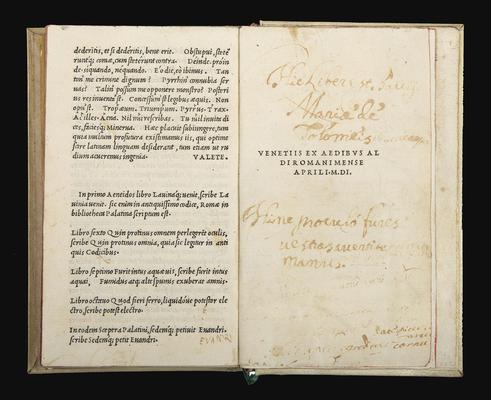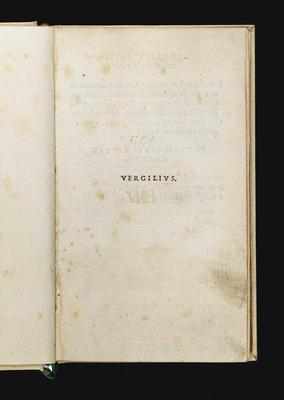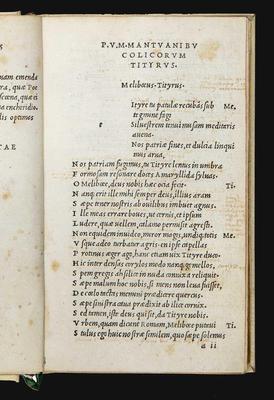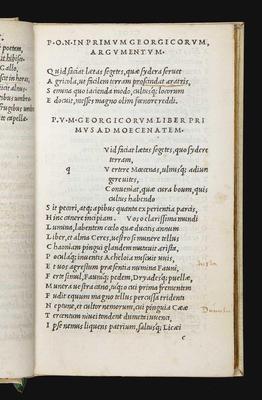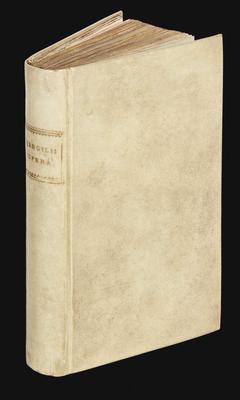Publius Vergilius Maro
Vergilius.
Venice, Aldus Manutius, April 1501.8° (143x89 mm). Collation: a-g8, A-X8, Y4. [228] leaves. Italic and roman type. Blank spaces for capitals, with printed guide letters. Nineteenth-century ivory vellum, over pasteboards. Smooth spine, title in gilt lettering. Green silk bookmark, gilt edges, formerly red. In a brown morocco box, made in 1982 by James Brockman. A good copy, slightly browned in places, repairs to the upper margin of fol. b4, a few marginalia lightly faded and trimmed. Underlinings and copious Latin and Italian marginal and interlinear notes in two minute humanistic hands. On the rear pastedown a cutting taken from the sale catalogue of Sotheby's (London, 11 January 1886, lot 2694), describing Michael Wodhull's copy, which states that “to procure the first Aldine Virgil in perfect condition is almost hopeless”.
Provenance: Baccio Maria di Neri de' Tolomei (1646-1694; Florentine senator in 1689, his ownership inscription on the recto of the last leaf, ‘Iste Liber est Baccij Mariae de' Tolomeis'); H. P. Kraus, August 1981 (see also Fifty Years. An Anniversary Catalogue of 120 Outstanding Books printed before 1700 and sold by H. P. Kraus from 1932 to 1982, New York 1982, no. 73); Garden Library (ex-libris on the front pastedown; Sotheby's, The Collection of the Garden Ltd. Magnificent Books and Manuscripts, conceived and formed by Haven O'More, New York 1989, lot 35); Pierre Berès (Pierre Bergé & Associés, Alde Manuce 1450-1515. Une collection, Genève, 19 November 2004, lot 29); Livio Ambrogio collection.
The celebrated and exceedingly rare Vergilius of 1501, the first book in octavo format Aldus printed, as well as the first to be printed in italic type, based on the Italian cursive humanist script. To borrow the well-chosen phrase of H. George Fletcher, “thequintessential Aldine”. The new small italic type first used here was designed and cut for Aldus Manutius by the Bolognese punchcutter and typefounder Francesco Griffo, and was highly praised by Erasmus of Rotterdam for its clarity and legibility. Aldus's verses announcing his typographical invention to the learned world, and commending Griffo's technical skill,are printed on the verso of the first leaf. The legend arose that the font was very similar to Petrarch's handwriting. It was also attributed to other ‘distinguished' humanistic hands, for example that of Pomponio Leto, the scribe Bartolomeo di Sanvito, and Aldus himself. A prototype of the italic font was first used by Aldus in 1500, to set the five words which appear in the woodcut frontispiece to St Catherine's Epistole. The Vergilius is the first book in the revolutionary series of Aldine classical texts issued in the easily portable octavo size, the libri portatiles in formam enchiridii immediately imitated, and often counterfeited by other printers in Italy as well as in France. The edition's italic type was also immediately imitated or counterfeited, despite the ten-year privilege granted by the Venetian Senate giving Aldus exclusive right to its use. An outstanding copy, included by H. P. Kraus in the catalogue issued to celebrate the printed masterpieces which he sold as a bookseller during a career lasting over five decades.


